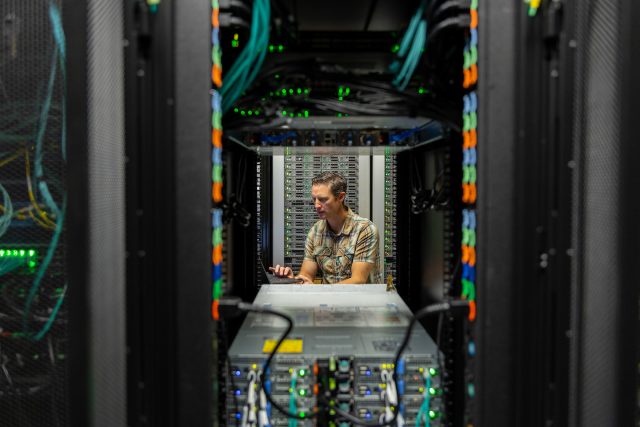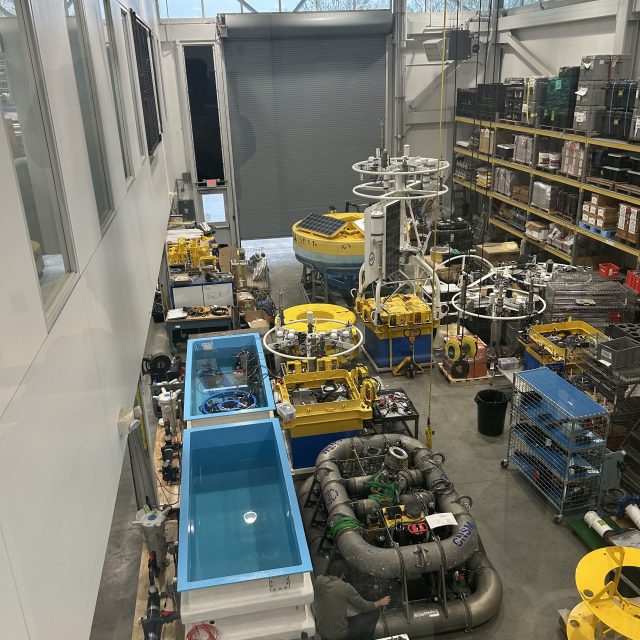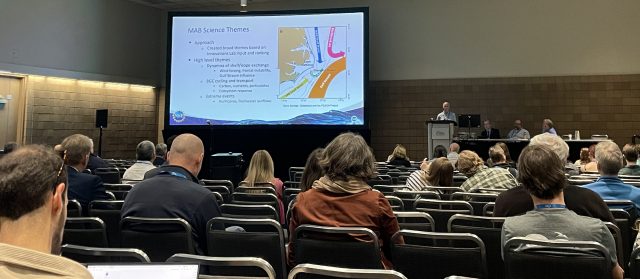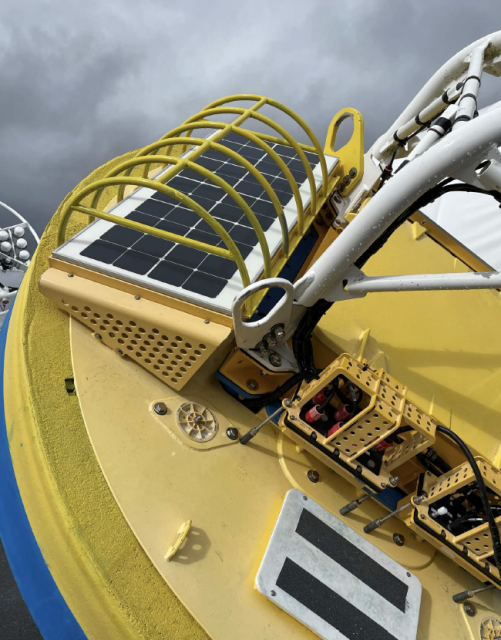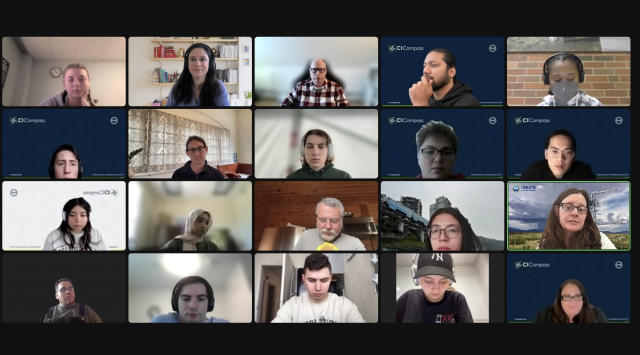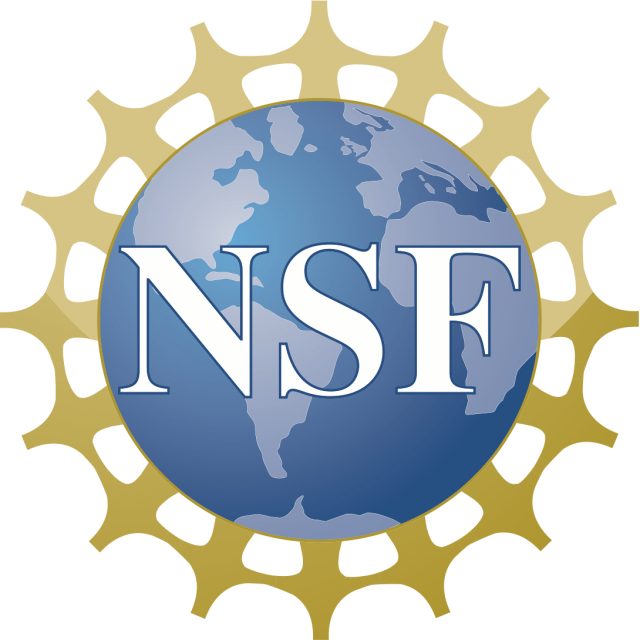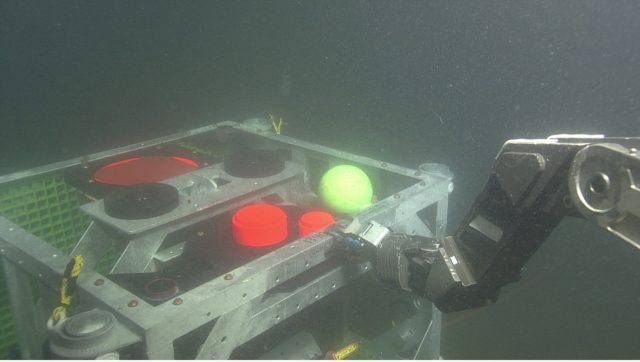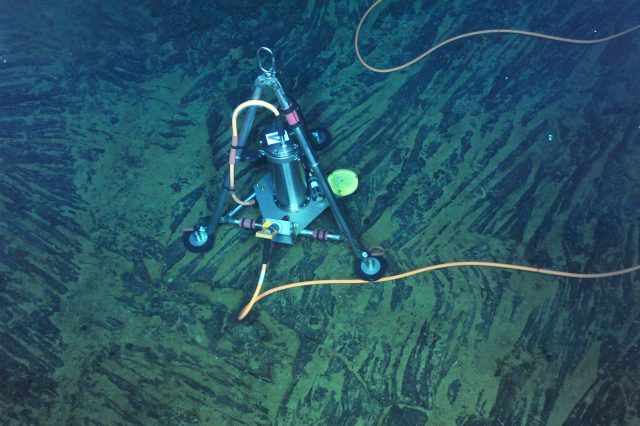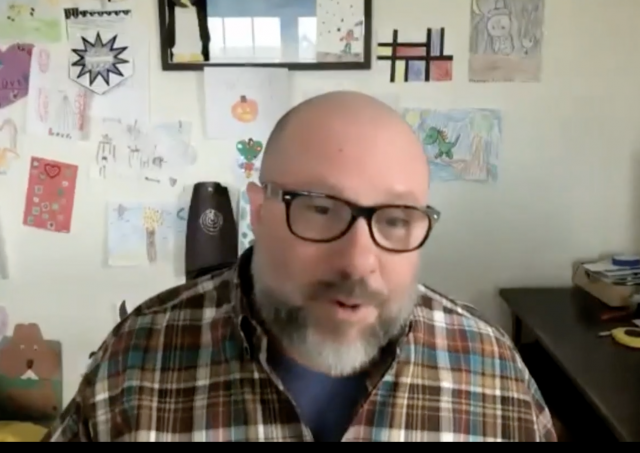News
OOI Data Center Progress Report
Craig Risien, project manager for the U.S. National Science Foundation Ocean Observatories Initiative (OOI) Data Center, likens the role of the OOI Data Center to that of Gmail or Google Drive. “When people log into Gmail, it just works. They don’t think about servers, networking, backing up and whatever else behind the scenes is required to allow you to just log into your Google environment and send emails, create documents, or move or download files. Typically, people don’t think about that back-end infrastructure. That’s the type of user experience we are looking to achieve when we create data services such as the OOI JupyterHub”. After two years at the helm of helping plan and build the new OOI 2.5 Data Center at the Oregon State University, Risien says the Center is functioning well and users are starting to take advantage of OOI provided infrastructure such as the OOI JupyterHub for research and teaching.
Oregon State University (OSU) was awarded the contract to run OOI’s Data Center starting in October 2020. In three and a half years, the Data Center team built two data centers. To accomplish this, they migrated two data centers, the original OOI Data Center at Rutgers University to OSU, and then the OOI 2.0 Data Center to the new OOI 2.5 Data Center. The data team at OSU accomplished all of this with virtually no downtime for both data center migrations.
“We’ve had less than 90 minutes of total downtime, when we transferred data to the current servers at OSU,” explained Risien. “And the majority of that downtime wasn’t because of hardware issues or moving data, we actually took the opportunity presented with these kinds of migrations to improve the system and make it work better for the next five years.”
The system downtime was associated with hardware migrations, when the team had to switch over old firewalls to new firewalls. This switch required physically unplugging fiber cables from off old firewalls and shifting them over the new ones. This switch was made early in the morning so there was no significant impact on the system availability. Risien laughed and said, “I think the total downtime there was about 20 minutes.”
[media-caption path="https://oceanobservatories.org/wp-content/uploads/2024/03/Risien-OOI_mi_010.jpeg" link="#"]Craig Risien, project manager of the OOI Data Center, working on computer infrastructure at the Data Center, located at the Oregon State University in Corvallis, Oregon. Credit: Maia Insinga, OSU.[/media-caption]The team used the limited downtime when data were being migrated to a new storage cluster to disaggregate development software environments and to change the network design.
“We seized on the transfer to a new storage cluster to put network segmentation in place, in other words we segment our network into different streams for different applications,” added Risien. “This improves our security posture because it makes it harder for somebody to move laterally through the system. It also allows for optimizing network performance and provides us with greater control over network traffic.”
Cybersecurity improvements
These successful data migrations are only the tip of the iceberg of what OSU’s data team has achieved over these past few years. Working with Dell, which provides the cyberinfrastructure hardware, the team shifted from a tape to disc-based backup solution. In addition to an existing tape backup library at the Texas Advanced Computer Center, OOI’s data are now routinely backed up to a geographically remote storage cluster in Bend, Oregon. “Backing up OOI data on disk in Bend is important because we now have an immutable copy of OOI data in a remote location. This means we could recover from a disaster much faster than with data stored on tape. Disc recovery would take days to weeks, as opposed to possibly many months from data stored on tape.”
Other cybersecurity improvements have been made over the last few years. The Data Center now has a storage solution – a Dell Data Domain – that provides an “air-gapped” backup of virtual machines that do the system monitoring, computation, and data delivery to end users.
During the third week of March 2024, a copy of all raw data and virtual machine backups to the storage cluster in Bend was completed. The transfer of 1.8 PB of data took about 10 days to complete with transfer rates at times exceeding 60 Gb/s, which is about 20 times faster than the transfer speeds a person will typically see when copying data to an external solid state hard drive.
“Obviously scientific data are critical in a recovery situation, but so are the virtual machines that process the data,” added Risien. “This air gapped backup of our virtual machines would allow us to recover far faster in a disaster recovery situation. We take security, backing up of data and our virtual machines very seriously. About third of our budget was spent on the systems that create these air gapped immutable backups of our data and virtual machines to make sure OOI data are secure and retrievable, if needed.”
A massive data transfer
Risien attributed the success of seamlessly transferring vast amounts of data and hundreds of virtual machines to the improved network speeds and technologies involved. One example he gave was the compute cluster, which consists of 16 VxRail appliances that run the virtual machines. “Using VMware VMotion we were able to move hundreds of running virtual machines from our OOI 2.0 VxRail clusters to the OOI 2.5 cluster, with no downtime or service disruptions, unbeknownst to our program partners or external users, which I find remarkable.”
What else is remarkable is that this data transfer and security improvements were accomplished in a seamless way by a very small team. In addition to Risien, Anthony Koppers serves as Cyberinfrastructure Principal Investigator (PI), Jim Housell as the IT Architect, Casey Dinsmore as the DevOps Engineer, and Pei Kupperman, as the Finance Lead. “Our small team was able to move this massive amount of data, securely without downtime, in part because of a really productive partnership with Dell, which brought a complete solution to the table. And we’ve worked with other great partners at the Cascade Divide Data Center, and the OSU networking team, without whom we wouldn’t have been able to make the connection out to Bend. Good partnerships, and great people coming together was what made this all happen.”
.
Read More
First Deployment of the Pioneer Array in the MAB
At 0900 Eastern on Monday April 1, 2024, the R/V Neil Armstrong will back out of the dock at Woods Hole, MA to begin the transit to the new location of the U.S. National Science Foundation (NSF) Ocean Observatories Initiative (OOI) Coastal Pioneer in the Mid-Atlantic Bight (MAB). This promises to be a momentous trip for it will be the first deployment of the Pioneer in the MAB, a location decided upon after a series of NSF-sponsored meetings with community users of OOI data. The expedition also will mark the 20th Pioneer deployment undertaken by the Coastal and Global Scale Nodes (CGSN) team at Woods Hole Oceanographic Institution (WHOI).
“The array is design to provide data to help scientists better understand the dynamics of the region, the role of biogeochemical cycling and transport, and the impact of extreme events like hurricanes and freshwater outflows,” said Albert Plueddemann, chief scientist for this first deployment and lead scientist of the CGSN group. “There’s already considerable community interest in obtaining data from the OOI infrastructure and leveraging the array installation for research and testing. Once the array is in place, we anticipate even more interest, and look forward to engaging with researchers in the region.”
The Pioneer MAB is a T-shaped array with moorings, located offshore of Nags Head, North Carolina, at depths of 30-300 meters and nominal spacing of15-25 kilometers. The array will consist of ten platforms at seven different sites – two platforms will be deployed as adjacent pairs at three sites. The platforms include three surface moorings, five profiler moorings, and two shallow-water moorings. The Pioneer MAB will also have mobile assets—four coastal gliders and two autonomous underwater vehicles (AUVs). These mobile assets will traverse the water column along different track lines to give a fuller, more robust picture of water column properties.
[media-caption path="https://oceanobservatories.org/wp-content/uploads/2024/03/MAB-Array-map-3-scaled.jpg" link="#"]Figure 1: Location of moorings of the Coastal Pioneer Array in its new location in the Mid-Atlantic Bight.[/media-caption]After a ~36-hour transit to the site, the team of 15 scientists and engineers will get to work to deploy the new array. Because of the large size of the moorings, the expedition will be conducted in two legs and be completed on April 22nd. In addition to the mooring and mobile asset deployments, the team will be conducting CTD (to measure conductivity, temperature, and depth) casts with water sampling at the deployment sites. In addition, they will be making ship vs meteorological comparisons at the surface mooring sites to ensure the rigor and accuracy of meteorological measurements. They also will be conducting some shipboard underway surveys, as well as a bathymetric survey to gain a complete picture of the new location.
[media-caption path="https://oceanobservatories.org/wp-content/uploads/2024/03/IMG_0550-2-scaled.jpg" link="#"]A lot of equipment is at the ready! Northern and Southern Coastal Surface Moorings, along with seabed multi-function nodes and near-surface instrument frames, as they were being assembled. The team integrates the science instrumentation with the mechanical/power/telemetry/data systems, then tests the system before loading on the vessel. Credit: Derek Buffitt © WHOI.[/media-caption]Continuing the tradition of the Coastal Pioneer Array off the New England Shelf, this first deployment expedition will be a collaborative one. A marine mammal observer from the National Oceanic and Atmospheric Administration will be onboard to count marine mammals in the region. A representative from the Northeast U.S. Shelf Long-Term Ecological Research (NES-LTER) will be onboard to conduct sampling from CTD casts and flow cytometers, which can analyze the characteristics of cells found in water as the ship is underway. This will be a continuation of an ongoing collaboration for the past seven years. And a Department of Energy representative will also be onboard as tests are conducted to determine the viability of placing a wave energy conversion device on the array.
Along with being the first deployment in the Southern Mid-Atlantic Bight, the Pioneer MAB Array will also include new instrumentation on the three Surface Moorings. The new instrumentation includes plankton imaging sensors (the McLane IFCB), instruments that measure particle size distribution (the Sequoia LISST-200X), short-range velocity profile instruments for the upper water column (the Nortek Aquadopp Profiler-S1VP), turbidity sensors (the Sea-BIrd ECO), and new seafloor pressure sensors (the RBR Quartz3QPlus). These were among the measurements recommended during the National Science Foundation OOI Facility Board community workshops in 2021 to select a new location for the Pioneer Array.
[media-caption path="https://oceanobservatories.org/wp-content/uploads/2024/03/IMG_0554-2-scaled.jpg" link="#"]Sheri White and Nikki Arm prepare and bench test the new Imaging Flow CytoBot, also known as a Plankton Imaging System (PLIMS), that will be deployed on the Central Surface Mooring of the new Pioneer MAB array. The PLIMS generates images of the particles in the local aquatic environment. Credit: Derek Buffitt © WHOI.[/media-caption]
Read More
Call for Applications for OOIFB
[Application Deadline: April 24, 2024]
The U.S. National Science Foundation (NSF) Ocean Observatories Initiative Facility Board (OOIFB) is tasked with representing the science community and users of the NSF Ocean Observatories Initiative (OOI) Facility. The OOIFB works to expand scientific and public awareness of OOI, and ensure that the oceanographic community is kept informed of developments of NSF OOI.
The OOIFB is soliciting applications to fill two membership positions that will open as of June 1, 2024, and run through June 1, 2027. Each selected individual will then be eligible to serve an additional 3-year term. The OOIFB holds at least one in-person meeting per year and one web conference each month.
Scientists, spanning water column to seafloor expertise, as well as experimentalists, engineers, and modelers, with experience using scientific observing systems, such as the OOI, are encouraged to apply. All interested applicants will be considered.
The responsibilities of the OOIFB may include, but are not limited to, the following:
- Serving as the prime scientific and technical conduit between the oceanographic community and NSF regarding OOI.
- Examining the accomplishments and work flow of the NSF OOI Operator, in order to provide feedback regarding the NSF OOI Annual Work Plans (AWPs).
- Via workshops, community meetings, and/or other mechanisms, stimulate and engage the user community in order to keep the accomplishments of the NSF OOI at the cutting edge of scientific inquiry and technological innovation.
- Developing and implementing strategies to expand scientific and public awareness of the unique scientific and technological opportunities of the NSF OOI.
- Helping to identify collaborative relationships with potential governmental, industrial, educational, and international partners in the NSF OOI, where appropriate.
- Ensure fair and consistent access to the NSF OOI by all sectors of the user community.
Applications should be submitted to Holly Morin, at the OOIFB Administrative Support Office (holly@ooifb.org), and must include a letter of interest and a CV. The statement of interest should highlight the applicant’s experience using observatory data and have fostered an environment of respect in their research endeavors.
Please note, applications cannot be accepted from individuals affiliated with the NSF OOI Program Facility institutions (Woods Hole Oceanographic Institution, Oregon State University, and the University of Washington), individuals under contract with the NSF OOI Program, and individuals from institutions already represented on the OOIFB (the current list of OOIFB members is available HERE).
Applications are due by April 24, 2024. Applications will be reviewed by the OOIFB, who will give due consideration to the qualifications of applicants, as well as the maintenance of gender, career level, discipline, and regional balance on the OOIFB. For more information about OOIFB and its activities, please visit the website, or contact Dax Soule, OOIFB Chair (Dax.Soule@qc.cuny.edu).
Read MoreEndurance Array Reaches 20th Deployment
Since 2014 when the U.S. National Science Foundation Ocean Observatories Initiative Coastal Endurance Array was first deployed in the waters off the coasts of Oregon and Washington, the array has been turned – that is moorings were recovered and replaced with new – 19 times. The upcoming expedition on March 28th, with 15 scientists and engineers aboard the R/V Sikuliaq will be the 19th time that the array has been pulled out of the water and replaced, and the 20th time the array has been deployed.
Over the past nine years, the turns have happened every six months, except for in 2020 when COVID restrictions caused the Endurance team to space two consecutive turn cruises 9 months apart. Regular recovery and deployments are needed to ensure the observing equipment stays operational.
“The EA team has really gotten proficient at turning the arrays,” said Jonathan Fram, the Endurance Array’s Project Manager, who will serve as the Chief Scientist for this expedition, his 10th time leading the effort. “We’ve made many technical improvements over the years to combat the powerful and ever-changing conditions of the Northeast Pacific Ocean so that we can continue to collect and report continuous ocean data from this important region.”
The 20th expedition will begin and end at the Oregon State University’s newly renovated pier in Newport, Oregon. The arrays and associated equipment will be transported to Newport from Corvallis in six tractor trailer trucks. Because of the large size of these components, the expedition will be conducted in two legs. The first leg will head to the Washington site, with a transit time of 2/3’s of a day. The second leg will be to the Oregon site. In total, the team will recover and deploy six surface moorings (two battery powered buoys and four large buoys powered by wind and solar energy), one offshore and three surface piercing profiler moorings, and four gliders. One glider experiencing navigation issues will be recovered. CTD casts (to measure conductivity, temperature, and depth) and water sampling will be conducted along with each mooring operation.
This 20th trip includes several technical improvements. The line used on the Heavy Lift Winch has been increased in size to improve load strength and safety. Each buoy will include a covered wagon style guard against sea lions, who regularly use the buoys as rest stops. All batteries have been replaced or upgraded. Additional improvements have been made that will result in better real-time wind data, and underwater camera operations. The Endurance 20 team also will be deploying new test instruments to see if they might improve data gathering for wind, pH, and partial pressure of carbon dioxide.
[media-caption path="https://oceanobservatories.org/wp-content/uploads/2024/03/Screenshot-2024-03-21-at-11.54.35-AM.png" link="#"]To dissuade sea lions that regularly stop and rest on Endurance Array buoys, OOI engineers have ingeniously devised a steel cover to protect the solar panels that provide power to the mooring. Credit: Jonathan Fram, OSU.[/media-caption]“The order of operations will in part depend on conditions,” added Fram, who joked, “but we expect this trip to be easier than last spring’s, which was three weeks earlier, when we were preparing for the cruise in the snow.”
In addition to regular operations, the Endurance Team will be joined by scientific partners. University of South Carolina (USC) researcher Eric Tappa and Oregon State University (OSU) student Faith Schell will be onboard to help turn a sediment trap adjacent to OOI’s Oregon Slope Base site. This is part of an ongoing research effort of OSU Associate Professor Jennifer Fehrenbacher and USC Professor Claudia Benitez-Nelson, who study the geochemistry, biomineralization, and marine biology of the sediments. Additionally, the team will be deploying fish tag readers for OSU Assistant Professor Taylor Chapple to support his work studying sharks and other large marine predators.
The expedition’s progress will be reported daily. Bookmark this page and follow along as the work unfolds.
Read More
Sharing OOI’s Cyberinfrastructure with NSF COMPASS Fellows
On Thursday March 7, 2024, Senior Manager of Cyberinfrastructure and OOI Data Lead Jeffrey Glatstein introduced a group of 18 students and seven instructors in the National Science Foundation’s CI Compass Fellowship Program (CICF) for Undergraduates to the challenges of collecting, distributing, and keeping safe OOI’s vast amount of data. Students Fellows in CICF learn about real-world cyberinfrastructure challenges, and how to begin solving them for NSF Major Facilities
Glatstein first gave the group an overview of the type, amount, and diversity of data OOI collects from more than 900 instruments. The collected data consists of 135 billion rows of numerical data, 1.2 petabytes of raw data and nearly 10,000 hours of high-definition video, 327,000 hours of audio recordings, and 1.28 million digital still images.
He then shared OOI’s data delivery track record. Since 2016, OOI has responded to 987 million requests for calculated data, providing 333 terabytes of data.
[media-caption path="https://oceanobservatories.org/wp-content/uploads/2024/03/240307_OOI-Jeff-Glatstein_3.png" link="#"]Senior Manager of Cyberinfrastructure and OOI Data Lead Jeffrey Glatstein (green highlighted screen) discussed OOI’s cyberinfrastructure with 18 COMPASS Fellows and their instructors. Credit: CICF.[/media-caption]Glatstein then went into detail about OOI’s extensive cybersecurity measures, which includes multiple storage sites with duplicate data to ensure that if the primary system went down, it could be quickly restored. This is particularly important for OOI because its stores data for posterity for future use in long-term time-series.
The students were amazed and engaged, as demonstrated by multiple questions after the presentation. Said Glatstein, “I enjoy sharing our work with students. It helps open their eyes to career opportunities in unexpected areas, like the ocean sciences, and their questions provides another way into looking at the work that we do.”
Read More
NSF Announces Solicitation for OOIFB Support Office
Bio-acoustic Sonar Echograms
The U.S. National Science Foundation Ocean Observatories Initiative (OOI) deploys bio-acoustic sonar instruments at all Arrays. Modified Kongsberg EK-60 instruments (ZPLSC-B) are deployed at the OOI Regional Cabled Array (RCA) on the seafloor at the OOI Endurance Array Oregon Shelf site (80 m depth) and at 200 m depth on the cabled mooring at the OOI Endurance Array Oregon Offshore site (Fig. 1). The EK-60s are being replaced with the newer EK-80 instruments, which came online during Summer 2023. ASL Environmental Sciences AZFP instruments (ZPLSC-C) are mounted on Surface Mooring Multi-Function Nodes (MFNs) at the Endurance Array Oregon and Washington Inshore sites and the Washington Shelf and Offshore sites, and formerly at the Pioneer NES Array Inshore, Central and Offshore sites (Fig. 2). At the Global Arrays (Irminger Sea, Station Papa, and formerly Argentine Basin and Southern Ocean), upward and downward looking AZFP instruments (ZPLSG-A) are mounted in the top spheres of the Hybrid Profiler Moorings (~150 m depth).
[media-caption path="https://oceanobservatories.org/wp-content/uploads/2024/03/ROPOS.jpg" link="#"]Figure 1. Upper: The ROPOS ROV releasing the tungsten carbide calibration sphere on the Oregon Shelf (80 m) bioacoustic sonar platform. The EK60 transducer heads are orange. Credit: UW/NSF-OOI/CSSF; Dive R1792; V14. [/media-caption] [media-caption path="https://oceanobservatories.org/wp-content/uploads/2024/03/Jason.jpg" link="#"]Figure 1. Lower: The Jason ROV hovers above the Oregon Offshore Shallow Profiler platform in 200 m water depth, amid a swarm of krill. The neon orange EK80 sonar transducer heads are visible on the far left. Credit: UW/NSF-OOI/WHOI, Dive J2-1516, V23.[/media-caption]The bio-acoustic sonar data are best visualized using echograms, which require processing the data then plotting the data products. In order to provide more accessible data products to the science community, OOI is generating echograms using the Python package Echopype. The Python code used and developed by OOI to generate the echograms via Echopype is freely available on GitHub. Data from the Endurance, Pioneer, and Global ASL AZFP instruments are processed from recovered instrument data, post-deployment. (Data Explorer refers to this as “Recovered Host” data.) The processing generates daily and weekly NetCDF files of the processed data as well as weekly echograms (Fig. 3), all available in the OOI Raw Data Archive (see the above-referenced GitHub README for file paths). Comparable processing will occur with data from the RCA Kongsberg EK-60 and EK-80 instruments; however, the processing will occur daily as new data are delivered to shore. In addition, the converted raw data files, formatted following the ICES SONAR-netCDF4 convention and produced by Echopype, are also in the Raw Data Archive.
[media-caption path="https://oceanobservatories.org/wp-content/uploads/2024/03/Transducers.jpg" link="#"]Figure 2. Picture of the ZPLSC-C transducers mounted on the Pioneer Central Surface Mooring MFN. The transducers are angled at 15 degrees away from the mooring riser to reduce interference. © WHOI.[/media-caption]The Echopype-generated NetCDF files from the Raw Data Archive are compiled into the longer time-series visualizations and are available in Data Explorer. More data have been added since our online July 2023 Town Hall, with a recorded version here.
For more information about research using bio-acoustic sonar data, and using the Echopype software, see this excerpt from the OOI Science Plan, 2021. Another example using raw data can be foundhere.
[media-caption path="https://oceanobservatories.org/wp-content/uploads/2024/03/Eclipse.png" link="#"]Figure 3. Example echogram from the RCA managed, Coastal Endurance, Oregon Offshore Cabled Shallow Profiler Mooring (CE04OSPS). Data were collected from 2017-08-20 through 2017-08-27. Of special note is the total solar eclipse that occurred on 2017-08-21. The path of totality passed directly over this site on the morning of 2017-08-21. The response of the zooplankton to the changing light levels can be seen in a brief reversal of the diel vertical migration as the eclipse reached totality at 18:16 UCT (as shown in area with dotted white lines).[/media-caption]
Read More
Pioneer MAB Array Workshop Applications
Old Dominion University, Norfolk, VA
The Ocean Observatories Initiative Facility Board (OOIFB) will host a community workshop focusing on current and future initiatives that can be addressed using data from the National Science Foundation’s (NSF) OOI Coastal Pioneer Array, which is planned to be relocated to the Southern Mid-Atlantic Bight. The workshop will be held at the Webb University Center, Old Dominion University, in Norfolk, VA, on September 10-12, 2024.
The event will bring together a diversity of scientists, resource managers, educators, and other stakeholders to learn about the capabilities of the Coastal Pioneer MAB Array and the cutting-edge research that can be done in this new location. The workshop also will provide a forum to facilitate cross-network collaborations, identify strategies for better engaging current and future users of the NSF’s OOI, and foster the research and proposal development process. NSF OOI Program team members and NSF representatives will be on hand to answer questions and provide information on NSF OOI operations.
Researchers who are using or are considering using NSF OOI data; resource managers from national, state, and tribal agencies; and educators at all levels interested in using data from the NSF OOI Coastal Pioneer MAB Array are encouraged to participate in this community workshop. To apply for the workshop, please complete the online application form that is available on the workshop web page. Travel support is available, but limited. Broad representation from institutional, geographic, and disciplinary groups is desired and will be considered in participant selection. The deadline for applications is March 26, 2024.
Additional details about the workshop and agenda are available here. If you have any questions, please be in touch.
Is Axial Seamount Napping?
Oregon State University Researcher Bill Chadwick attempted to answer this question in a poster he presented at AGU in December 2023. Chadwick has been watching the “ups and downs” of Axial Seamount for more than 30 years, including its last eruption in 2015. He and other observers monitor the seamount’s activity using bottom pressure recorders (BPR) connected to the US National Science Foundation Ocean Observatories Initiative (NSF OOI) Regional Cabled Array (RCA), operated by the University of Washington, along with additional uncabled BPRs and Mobile Pressure Recorder surveys at an array of seafloor benchmarks every two years using a remotely operated vehicle.
[media-caption path="https://oceanobservatories.org/wp-content/uploads/2024/03/BPR-scaled.jpg" link="#"]A repeatable inflation-deflation cycle has been documented at Axial Seamount over the last 30 years, using autonomous, battery-powered Bottom Pressure Recorders (BPRs), and later cabled-BPRs like this one connected to the OOI-RCA. Credit: UW/NSF-OOI/CSSF, 2014.[/media-caption]“Axial Seamount has erupted three times in the last 25 years. As of March 2024, the seamount is 90-95% reinflated to the level it reached before the 2015 eruption, so we’re getting close to the eruption triggering point,” said Chadwick. “But on the other hand, the rate of inflation, which started high right after the 2015 eruption, has been decreasing and decreasing since then.”
The inflation rate reached nearly zero last summer (just slightly positive at ~1 cm/year, the lowest rate seen at Axial). “At that very low rate, it was hard to tell how long it would take to reach the 2015 inflation threshold,” Chadwick added.
Since October 2023, however, the rate of uplift has been slowly increasing. University of Washington Researcher William Wilcock’s Axial Seamount Earthquake Catalog page also indicates the seismicity has been on the rise since October 2023, with a large swarm of >600 events on 10 February.
“Since October 2023, the rate of inflation has increased a bit to 5-6 cm/yr, which is still quite low compared to rates we’ve seen over the last 25 years but seems to indicate that Axial may be coming out of its slumber of last summer,” Chadwick explained. “And the earthquake swarm on Feb 10 also seems to support that notion.”
Longer-term eruptive history documented by mapping and dating lava flows at the summit shows that Axial has produced at least 50 eruptions in the last 800 years, (Clague et al., 2013), an average of one every 15-18 years, suggesting that the current lull at Axial might not be long.
“I’m hoping that the rate of inflation will continue to increase, but it’s too early to tell. Anything could happen,“ Chadwick added. “I’m more hopeful than I was a year ago that the next eruption may not be too far off but only time will tell!”
[media-caption path="https://oceanobservatories.org/wp-content/uploads/2024/03/Chadwick-dots.jpg" link="#"]Map showing the locations of Mobile Pressure Recorder (MPR) benchmarks, as well as the autonomous and cabled Bottom Pressure Recorders (BPR). The red dots are the BPRs connected to OOI Regional Cabled Array.[/media-caption]
Reference: Clague, D.A., et al., (2013) Geologic history of the summit of Axial Seamount, Juan de Fuca Ridge, Geochem Geophys, Geosystems, doi: 10.1002/ggge.20240.
Read More
Jupyter Hub Town Hall Video Available
In case you missed it, here is a video of the Jupyter Hub Town Hall on March 6, 2024.
To gain access to OOI Jupyter Hub, new users need to register email address at: helpdesk@oceanobservatories.org.
The Jupyter Hub url is: https://jupyter.oceanobservatories.org.
[embed]https://youtu.be/tGn9hGdenfw[/embed] Read More
